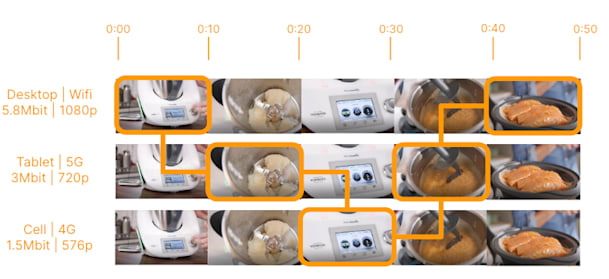Whether it’s watching an ad for a shoe you want to purchase or a how-to-use video for the new kitchen appliance you’ve purchased, we all have experienced the dreaded buffering. That annoying period when crisp images suddenly pixelate and charismatic speakers are frozen in time like Han Solo in carbonite.
Video plays an increasingly vital role in how brands engage with consumers but there is no better way to ruin the viewer’s experience than slow playbacks or buffering. The issue is especially acute on mobile, considering that buffering can lead up to 53% of viewers to quit watching the video.
Fortunately, streaming technology has evolved significantly in the last few years to prevent buffering issues. This article discusses a couple of ways brands can stream videos over the internet, without buffering, particularly focusing on Adaptive bitrate streaming (ABR) and how it ensures the best possible viewing experience while keeping bandwidth costs low.
Buffering happens when the bitrate of a streaming video exceeds the bandwidth available, which is typically determined by the playback device and the speed of internet connection. For instance, a high quality video (high bitrate) streamed on a mobile device with poor internet connection is likely to cause buffering. But simply lowering the video quality isn’t an option as it could mean losing the opportunity to engage desktop viewers with faster internet speeds.
As brands increasingly invest in immersive, high-quality video experiences, they need the flexibility to display the same video in varying resolution and bitrate to meet the needs of a global audience viewing the video across a variety of devices at home or on the go.
Progressive video streaming is one way to address the buffering issue. It essentially involves streaming the video at a bitrate optimized for the end-user’s device and internet connection. So desktop viewers on fast internet connection are able to view a higher resolution version whereas mobile viewers on slower internet connection get a lower resolution version based on the bandwidth available.
Unfortunately internet fluctuations brought on by any number of disruptions can impede or reduce bandwidth while the video is streaming, triggering that dreaded buffering. So, progressive video streaming is a great option when there is a shorter window for disruptions. For instance, short looping video on landing pages or product pages of an ecommerce site. But as the window for bandwidth fluctuations grows, the risk of buffering increases.
ABR specifically addresses the issue of bandwidth fluctuations that may occur while the video is streaming to ensure the best possible viewing experience. ABR is essentially a video packaging and delivery process in which streaming quality is adjusted in real-time based on available bandwidth to prevent buffering.
ABR works by encoding the video file into chunks of 2-10 seconds and by creating a number of streaming profiles that include a combination of codec, resolution, and bitrate. While the video streams, the playback device automatically selects the appropriate streaming profile for each chunk of video based on bandwidth available to maintain a smooth viewing experience.

There are best practices to ensure a high-quality video streaming experience with ABR while simplifying the implementation process. This includes
- On-the-fly encoding: Typically, the process of encoding the video into chunks and the creation of streaming profiles happens in advance when the video is uploaded to a server. However with on-the-fly encoding this process happens when the video is first requested to be viewed by an end-user. The advantage of on-the-fly encoding is it minimizes the need for any advanced data preparation on behalf of the video provider and the video can be streamed instantaneously as soon as it’s uploaded to the server.
- Content-aware profile selection: Automatic selection of streaming profile (combination of bitrate, format and resolution) based on the video content can ensure optimal usage of available bandwidth while maintaining a smooth viewing experience. For instance, simple one-shot scenes with fewer movements could use a streaming profile with lower bitrate and resolution whereas complex scenes could use a higher quality streaming profile.
- Streaming over HLS: ABR streaming over the HLS (HTTP Live Streaming) protocol can ensure efficient video compression with support for latest codecs (H.264 / H.265) while enabling video delivery universally to desktop, mobile, IoT, and more.
To conclude, brands and e-tailers seeking consistent, reliable video performance that doesn’t interrupt or annoy viewers must take advantage of ABR streaming to increase engagement and conversion.
Cloudinary’s end-to-end video solution offers full support for ABR streaming with on-the-fly HLS encoding, content-aware automatic profile selection and support for a wide range of formats (mp4, webm, avi, mov, mkv) and codecs (h.264, h.265, VP9, AV1). Additionally, Cloudinary offers progressive video streaming capabilities and on-the-fly video transformations such as adding branded watermarks, overlaying images on the video, trimming the video to remove unwanted content and adding subtitles to scale your video to global audiences.
For more information on Cloudinary’s video services, learn more and sign up for a free account.



